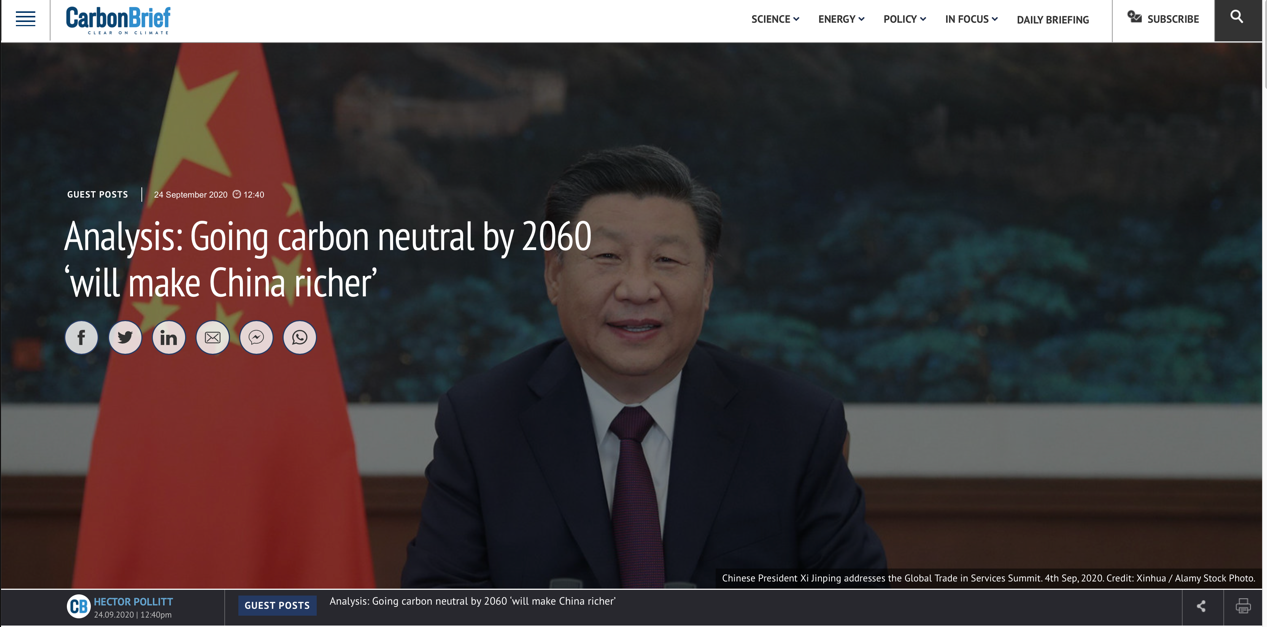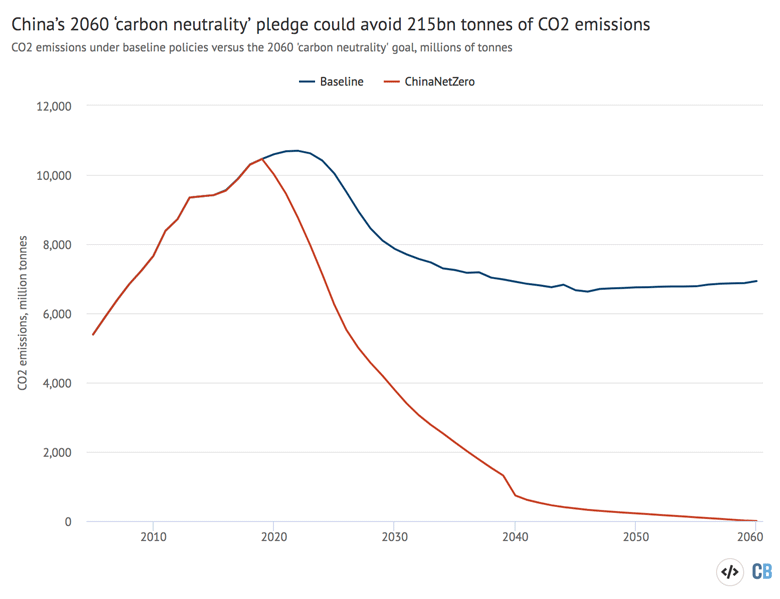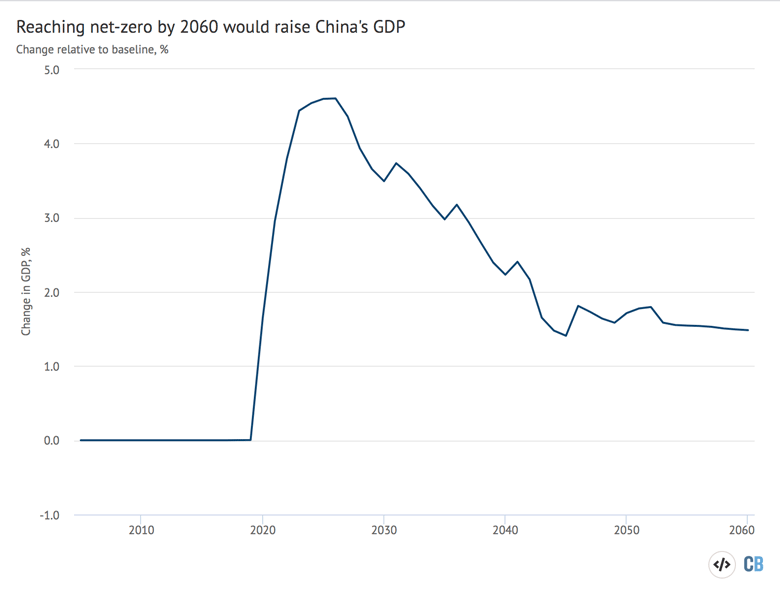本文转自《Carbon Brief》发表的题为“Analysis: Going carbon neutral by 2060 ' will make China richer' ”的报道。
原文链接:https://www.carbonbrief.org/analysis-going-carbon-neutral-by-2060-will-make-china-richer
日期:2020.09.24

HECTOR POLLITT 24.09.2020 | 12:40pm
China’s surprise pledge to reach “carbon neutrality” before 2060 could cut global warming this century by 0.25C and raise the country’s GDP, our new analysis shows.
我们的最新分析显示,中国出人意料地承诺在2060年前达到“碳中和”,这可能会使本世纪的全球变暖减少0.25摄氏度,并提高中国的国内生产总值。
The significant new announcement, made by president Xi Jinping at this week’s UN General Assembly, means that more than one sixth of the world’s population – and around a third of its CO2 output – has, overnight, been committed to net-zero emissions within 40 years.
国家主席习近平在本周的联合国大会上宣布了这一重要的新声明,这意味着全球超过六分之一的人口,以及约三分之一的二氧化碳排放量,一夜之间承诺在40年内实现净零排放。
We used Cambridge Econometrics’ E3ME macroeconomic model to analyse the implications of the pledge, finding that China’s CO2 emissions would need to fall rapidly to reach net-zero by 2060.
我们使用剑桥计量经济学的E3ME宏观经济模型分析了这一承诺的含义,发现中国的二氧化碳排放需要迅速下降,到2060年达到净零排放。
The huge scale of investments required to do this would raise China’s GDP by as much as 5% later this decade, with a modest ongoing positive impact due to reduced fossil-fuel imports.
为此所需的巨大投资规模将使中国的国内生产总值在这个十年后增长5%,同时由于化石燃料进口的减少,将产生适度的积极影响。
China’s investments would not only drive dramatic reductions in its own CO2 emissions, but would also lower the cost of clean energy, creating a positive “spillover” effect in other countries.
中国的投资不仅可以大幅减少本国的二氧化碳排放量,还可以降低清洁能源的成本,在其他国家产生积极的“溢出”效应。
In total, the pledge could mean global warming this century reaching around 2.35C, some 0.25C lower than the level expected in our baseline – even if others do not raise their own climate goals.
总的来说,这一承诺可能意味着本世纪全球变暖将达到2.35摄氏度左右,比我们的基准预期水平低0.25摄氏度——即使其他国家没有提高自己的气候目标。
Path to zero
归零路径
In order to push China to reach net-zero CO2 emissions by 2060 in our model, a whole range of policies would need to be implemented. The foundations are provided by a combination of energy efficiency rules and carbon pricing, built on the country’s nascent emissions trading scheme.
为了推动中国在我们的模式下到2060年实现二氧化碳净零排放,需要实施一系列政策。能源效率规则和碳定价的结合为基础奠定了基础,而碳定价建立在中国刚刚起步的排放交易计划之上。
China would also need to offer support for specific technologies to accelerate existing trends in their uptake – for example, via feed-in tariffs for renewables or subsidies for electric vehicles. It would also need to ensure that no new coal plants are built, emphasising the important role of regulation in directing markets towards net-zero emissions.
中国还需要为特定技术提供支持,以加速现有技术的发展趋势,例如通过可再生能源上网电价或电动汽车补贴。它还需要确保不新建燃煤电厂,强调监管在引导市场实现净零排放方面的重要作用。
These interventions would dramatically cut China’s CO2 emissions over the next 40 years, relative to what we would expect under existing policies and technology trends. Cumulatively, this would avoid the release of 215bn tonnes of CO2 over the next four decades, as shown in the chart below.
相对于我们在现有政策和技术趋势下的预期,这些干预措施将在未来40年大幅削减中国的二氧化碳排放量。累积起来,这将避免未来40年排放2150亿吨二氧化碳,如下图所示。

Modelled CO2 emissions in China under existing policies and technology trends (baseline, blue line) versus a pathway to net-zero by 2060 (ChinaNetZero, red), millions of tonnes of CO2. Source: Cambridge Econometrics modelling. Chart by Carbon Brief using Highcharts.
根据现有政策和技术趋势(基线,蓝线)模拟中国的二氧化碳排放量,对比2060年实现净零排放的途径(ChinaNetZero,红色),百万吨二氧化碳。来源:剑桥计量经济学模型。
It is worth noting that, in our modelling, the current policy baseline (blue line in the chart above) already suggests a rapid peak in China’s CO2 emissions before 2025, followed by a decline and longer-term plateau. Other research has already suggested the country could peak well before its previously pledged goal of “around” 2030.
值得注意的是,在我们的模型中,目前的政策基线(上图中的蓝线)已经表明,中国的二氧化碳排放在2025年之前会达到一个快速的峰值,随后是下降和长期的平稳期。其他研究已经表明,中国可能会在其先前承诺的“2030年左右”目标之前达到顶峰。
In our baseline modelling, the early peak in CO2 emissions is due to low-cost solar and wind starting to displace coal-fired generation in the electricity grid. This gives an insight into one of the potential motivations for China’s new carbon neutrality pledge.
在我们的基线模型中,二氧化碳排放的早期峰值是由于低成本的太阳能和风能开始取代电网中的燃煤发电。这让我们深入了解了中国新的碳中和承诺的潜在动机之一。
Global impact
全球影响
The reduction in China’s CO2 emissions that we modelled – a cumulative 215GtCO2 – is hugely significant relative to the remaining carbon budget for limiting warming to 1.5 or 2C.
我们模拟的中国二氧化碳排放量(累计215GtCO2)的减少,相对于将全球变暖限制在1.5或2摄氏度的剩余碳预算而言,意义重大。
But this is not the only way that the pledge could cut emissions, because actions in China can also cause “spillover” effects in the rest of the world. We have seen this already with solar panels, where high levels of demand in China have driben down prices all around the world.
但这并不是承诺减排的唯一途径,因为中国的行动也会在世界其他地区造成“溢出”效应。我们已经在太阳能电池板上看到了这一点,中国的高需求推动了世界各地的价格下跌。
This means that, even if the rest of the world did not implement any new climate policy in response to China’s raised ambition, emissions would still fall in other countries. Our modelling suggests this impact is far from trivial, reaching a saving of more than 500m tonnes of CO2 (MtCO2) per year.
这意味着,即使世界其他国家没有针对中国提出的雄心壮志实施任何新的气候政策,其他国家的排放量仍将下降。我们的模型表明,这种影响远非微不足道,每年可节省5亿吨二氧化碳(MtCO2)。
All told, our results show the CO2 cuts due to the 2060 pledge could avoid 0.25C of warming this century. This would mean temperatures rising to 2.35C above pre-industrial levels by 2100, instead of the 2.59C in our baseline scenario.
总的来说,我们的研究结果表明,由于2060年的承诺,二氧化碳减排可以避免本世纪全球变暖0.25摄氏度。这意味着到2100年,气温将比工业化前的水平高出2.35摄氏度,而不是我们的基准情景下的2.59摄氏度。
Our results are similar to the new findings published by Climate Action Tracker, which say the pledge could avoid 0.2-0.3C of warming.
我们的研究结果与气候行动追踪机构(climate active tracker)发表的最新研究结果相似,后者说,这项承诺可以避免0.2-0.3摄氏度的变暖。
The spillover effects that we found are not all positive. China’s rapid decarbonisation would reduce oil demand, meaning that global prices would fall by up to 5% and the transition to electric vehicles outside China would slow, relative to the baseline and assuming no additional policy interventions.
我们发现的溢出效应并非都是正面的。中国的快速脱碳将减少石油需求,这意味着全球油价将下跌5%,而且在没有额外政策干预的情况下,向中国以外地区的电动汽车转型将放缓。
Larger economy
大经济体
Decarbonising the world’s current largest emitter will not be cheap. The carbon price in our modelled pathway to carbon neutrality reaches $250/tCO2, in today’s prices.
对目前世界上最大的排放国进行脱碳并不便宜。按照今天的价格,我们建立的碳中和途径中的碳价格达到250美元/tCO2。
Relative to the baseline, investment in the power sector alone increases by $4tn (today’s prices, non-discounted) over the 40 years – and millions of people currently work in the coal sector.
与基准相比,在过去40年中,仅电力部门的投资就增加了4万亿美元(按今天的价格,不打折),目前有数百万人在煤炭行业工作。
However, much of the technology and equipment necessary for decarbonisation is made in China and the country has the capacity to produce more. The country would also substantially reduce its fossil-fuel import bill, at the same time as boosting its efforts to increase self-sufficiency.
然而,脱碳所需的许多技术和设备都是中国制造的,中国有能力生产更多的技术与装备。该国还将大幅削减化石燃料进口账单,同时加大力度提高自给自足。
As a result, China’s GDP increases in the net-zero scenario relative to the baseline, as shown in the chart below, with significant positive impacts particularly in the short term.
因此,如下图所示,中国的GDP在净零情景下相对于基线增长,具有显著的积极影响,尤其是在短期内。

Change in China’s GDP in the net-zero pathway, relative to the baseline, %. Source: Cambridge Econometrics modelling. Chart by Carbon Brief using Highcharts.
净零路径下中国国内生产总值的变化,相对于基线,%。来源:剑桥计量经济学模型。
The difference would be particularly large early on, reflecting all the investment required in renewables, but there would also be a smaller long-run benefit, thanks to lower fossil-fuel import costs. China’s energy security would also be improved.
这一差异在初期会特别大,反映了可再生能源所需的全部投资,但由于化石燃料进口成本较低,长期效益也会较小。中国的能源安全也将得到改善。
On the flip side, GDP in the rest of the world would fall slightly (<1%), driven by lower export revenues for oil and gas-producing countries – assuming no further policy response outside China. In aggregate, global GDP would go up, with the increase in China outweighing losses elsewhere.
另一方面,在石油和天然气生产国出口收入下降的推动下,世界其他地区的国内生产总值(GDP)将略有下降(<1%)——假设中国以外的国家没有进一步的政策反应。总的来说,全球GDP将上升,中国的增长将超过其他地区的损失。
It is important to note that these results do not include any feedbacks from the climate. By 2060, the physical impacts of climate change may be substantial.
值得注意的是,这些结果不包括任何来自气候的反馈。到2060年,气候变化的物理影响可能会很大。
Localised pain
局部疼痛
The model results suggest that, in aggregate, China will benefit from its new targets. However, there will be localised pain – for example, those millions of coal workers who may struggle to find other jobs and the parts of China that rely on coal extraction would be hit hard.
模型结果表明,总体而言,中国将从新目标中获益。然而,也会有局部性的痛苦,例如,数百万可能难以找到其他工作的煤矿工人,以及中国依赖煤炭开采的部分地区将受到沉重打击。
President Xi’s announcement suggests that he thinks this transition can be managed, with the benefits outweighing the costs. This position contrasts with that of the US, though the upcoming election could change that.
习主席的声明表明,他认为这种转变是可以管理的,利益大于成本。这一立场与美国形成鲜明对比,尽管即将到来的大选可能会改变这种状况。
What is clear for now is that China has laid down a marker at a time when many other countries are considering their climate commitments.
目前清楚的是,在许多其他国家正在考虑其气候承诺之际,中国已经打下了一个标杆。